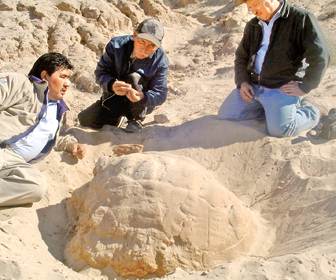La Voz de la Frontera
April 6, 2015
by Brenda Roman
San Luis, Colorado River (OEM) .- There has been a rash of theft of historical artifacts in San Luis Rio Colorado, so it was necessary to design actions to protect them, in order to preserve the treasures that can help reveal environments that existed in this locality thousands of years ago.
 From starfish to turtles and other marine and terrestrial species, the cliffs in the area north of El Golfo de Santa Clara, (which was once the bed of the Colorado River) is a nursery for fossils which represent great historical and in some cases economic value.
From starfish to turtles and other marine and terrestrial species, the cliffs in the area north of El Golfo de Santa Clara, (which was once the bed of the Colorado River) is a nursery for fossils which represent great historical and in some cases economic value.
The ecologist Martin Sua Cota, director of the Biosphere Reserve Upper Gulf of California and Colorado River Delta, commented on the existence of a "historic treasure" buried in the bed of the Colorado River, a land turtle discovered in 2007 .
Recently the Commissioner for Historical Affairs, Joaquín Robles, revealed the finding of other fossilized pieces, bones of a mastodon and camel, whose locations were not disclosed to prevent possible theft.
In an interview for the TRIBUNE San Luis, the historian said that there was an ongoing looting of historical pieces which were then sold in the US, where they had a high economic and evidently historic value.
Martin Sua believes the theft of very large fossilized pieces, such as those mentioned above, is less likely than the theft of bones from species such as starfish and bivalve dating back thousands of years.
"When the tortoise was discovered, which is considered a relative of the freshwater species, the Biosphere Reserve held the job of protecting the piece. We established a perimeter and posted a guard until the Sonora delegation of the National Institute of Anthropology and History (INAH), came to rescue and preserve it, which should also occur with the newly discovered pieces as the INAH are the only ones authorized to execute such actions," he said.
The INAH, competent authority
He said that the proper action is to give immediate notice to the INAH so they can perform conservation procedures because the bones, when exposed, are subject to natural deterioration and only the INAH can apply special techniques to protect them.
He explained that for many years the Colorado River brought fresh water, salts and minerals into the northern part of the Gulf, along the area of the road that presently connects to the fishing community.
Over time, as the cycle of fresh water in the Colorado River Delta continued, the cliffs eroded to reveal fossilized pieces, such as the tortoise discovered in 2007.
A crime to extract historical pieces
Sua Martin said when the Reserve staff detected the mastodon and camel artifacts, he reported the discovery to the INAH so they could properly extract and remove the bones. Anyone found transporting historic artifacts can be subject to a penalty.
The Gulf requires an anthropological museum
After the INAH recovered the tortoise discovered in 2007 and managed to stop the deterioration process, they made a commitment to return it to El Golfo de Santa Clara when the community had the means to publically display it.
The Regional Museum, located in the woods near the city, is no place for the exhibition of such pieces. A museum needs to be built inside the tourist town, at which point the INAH will consider returning the tortoise to its "home" .
Ask cooperation to safeguard history
"The cliff area of El Golfo is full of history and no doubt there is an illegal removal of parts of it, but as the Reserve does not have the ability to maintain constant vigilance, we invite members of the History Commission to join forces in designing a project to reduce such crimes," he stated.
Facts of the fossilized turtle
The tortoise, located in the vicinity of populated Golfo de Santa Clara, municipality of San Luis Rio Colorado, is between 400,000 to 1.9 million years old and belonged to the early Pleistocene period.
The specimen is 1 meter long, 85 inches wide and 50 inches high, and belongs to the class Reptilia, order Chelonia, Family Testudinidae Hesperotestudo, whose common name is "giant tortoise." The fossil was found in a canyon in the eroded area, about 15 meters deep with respect to ground level.